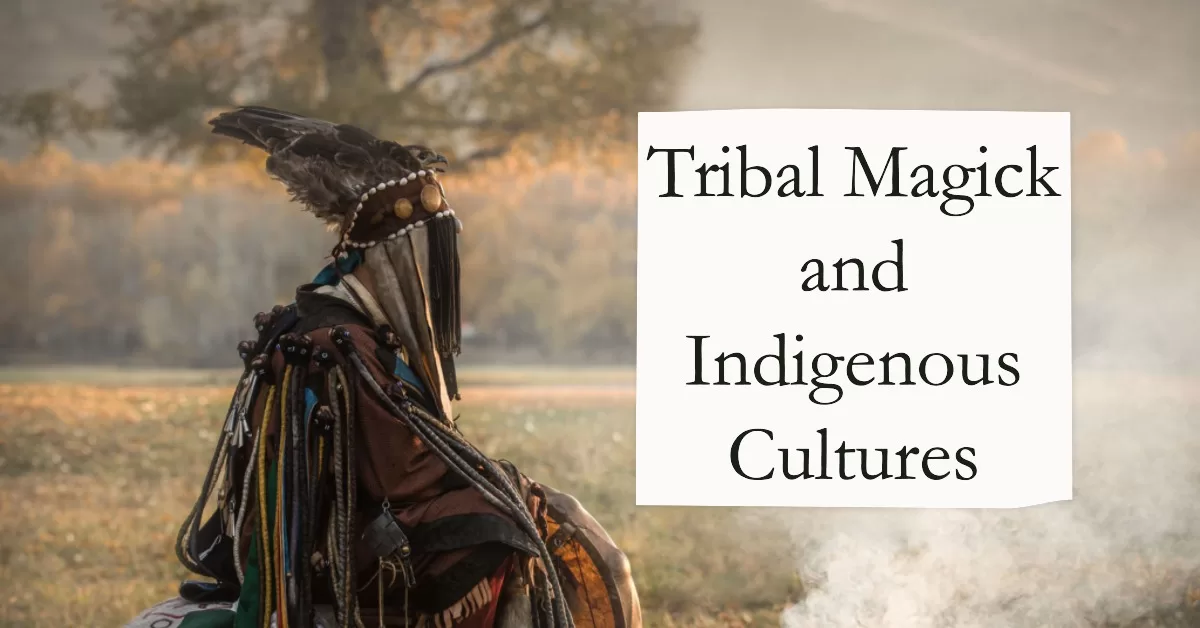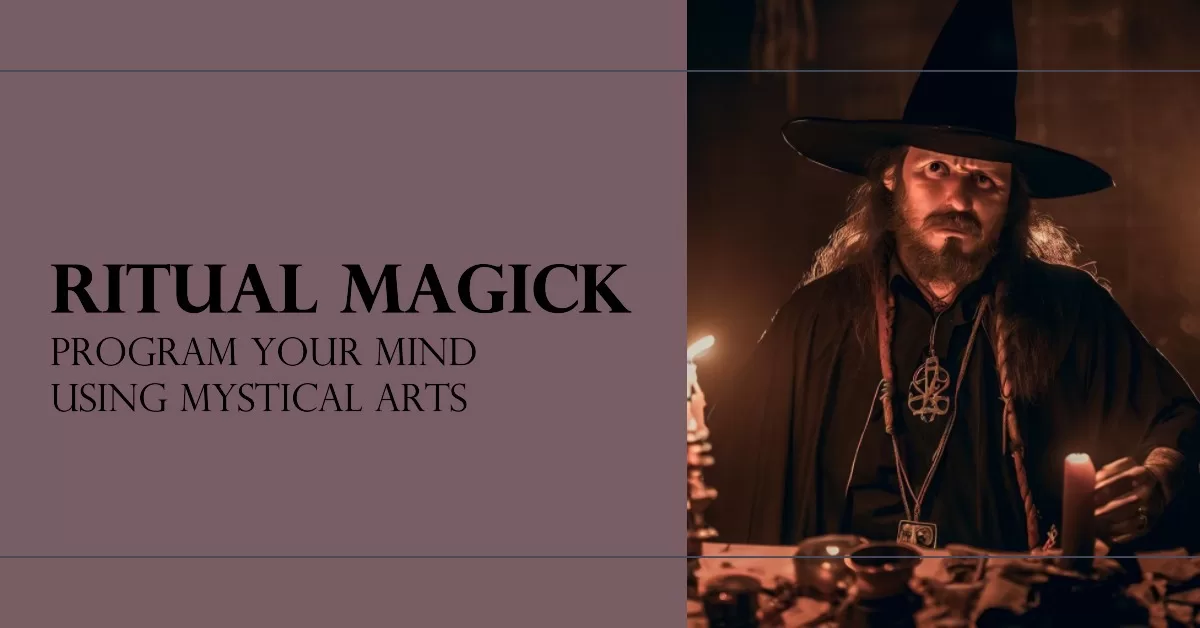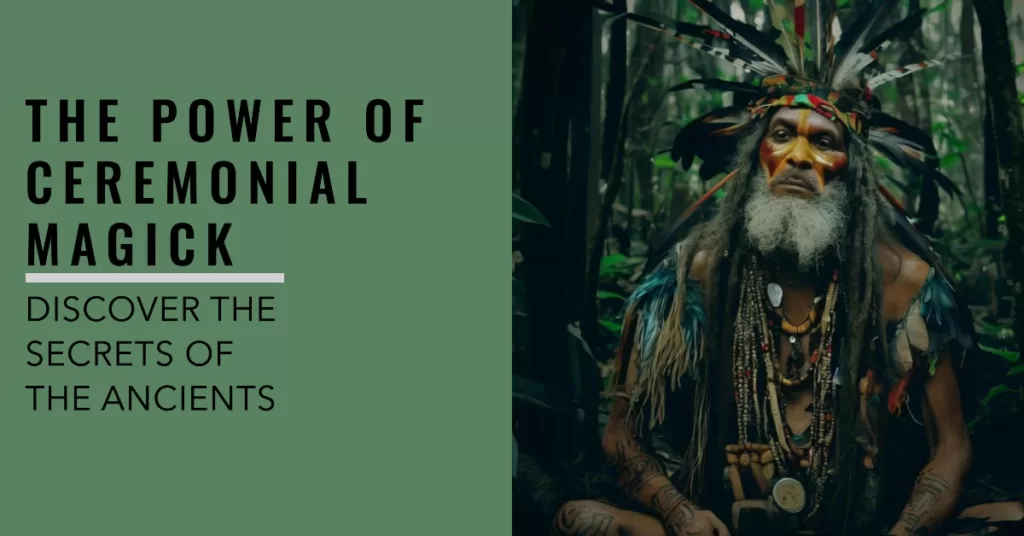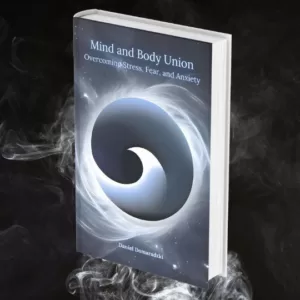Ritual and ceremonial magick has its roots in ancient cultures and is believed to have been practiced for centuries. It is a form of magick that involves the use of specific tools, rituals, and ceremonies to bring about desired results. This article will provide an overview of the history, types, and practices associated with this type of magick. It will also discuss how ritual and ceremonial magick can be used as a powerful tool to manifest one’s goals and desires. By understanding the fundamentals of this type of practice, it is possible to gain insight into the power available through ritual and ceremonial magick.
Note: From a scientific perspective, pre-defined rituals can serve us many psychological benefits. For instance, calmly drinking green tea before engaging in intellectual activities will make your brain associate these two activities so each time you drink tea, your mind and body start preparing for the task by entering “the smart mode”. Analogically, more complex activities like magickal rituals can serve as tools to reprogram your mind resulting in a mindset shift (e.g. by improving your self-confidence). A wise combination of ancient practices with modern psychology and neuroscience can be used with great success for performance coaching purposes.
Table of Contents
History, Origins, and Main Principles
The practice of employing ritual and ceremonial magick has its roots in antiquity. Magick, as employed in this context, is the use of symbols and their meanings for managing “supernatural” or spiritual effects. It was believed to be a means by which one could influence the divine or manipulate natural forces to bring about desired outcomes. The precise origin of these practices is unknown, but evidence suggests that they have been around for a long, long time (e.g. tribal shamans). In many cultures throughout history, symbols, and rituals were used to invoke good fortune or ward off danger.
Rituals and ceremonies often involve the creation and use of sacred objects such as talismans, charms, amulets, and other magickal symbolism with specific properties associated with them. These items are often imbued with power through a variety of methods such as incantations or invocations. In some cases, they can even be empowered through physical contact with an individual or object thought to possess special energy or abilities. This type of practice is often referred to as sympathetic magick – using something related to what you are trying to achieve in order to help manifest it into reality.
Sympathetic magick, also known as imitative magick, is a type of magick based on imitation or correspondence. It is the belief that by acting on something that is associated with another thing, you can affect the second thing. For example, if you want to harm your enemy, you might stick a pin in a doll that looks like them. Or, if you want to bring good luck, you might carry a lucky charm.
Sympathetic magick is often used in folk magick and witchcraft. It is also found in some religious traditions, such as Voodoo and Hoodoo.
There are two main types of sympathetic magick:
- Contagious Magick: This type of magick is based on the belief that by coming into contact with something, you can acquire its power. For example, if you want to be brave, you might wear a necklace made of lion’s teeth.
- Imitative Magick: This type of magick is based on the belief that by imitating something, you can cause it to happen. For example, if you want to make it rain, you might dance in the rain.
Sympathetic magick is often seen as a form of superstition. However, it is still practiced by some people today. There is no scientific evidence to support the claims of sympathetic magick being able to influence the external surroundings, but it continues to be a popular practice as it has the potential to cause intrinsic changes. For example, martial artists often practice on a kicking bag and visualize they are hitting their rival. It helps them increase self-confidence and decrease anxiety associated with the fight. Additionally, it can help non-martial artists release negative feelings such as wrath without actually hurting the person they despise and without getting into legal trouble. On a deeper level, it can also serve as a tool allowing one to personify undesirable character traits such as laziness or greed. By visualizing them as self-conscious entities and performing a magickal ritual that intends to tame and turn them into “friendly spirits”, this type of mental practice enables the adept to shift their mindset. Technomancy aka cyber magick is a similar type of practice (although based on a different symbolism) that uses the same principles, but instead of treating parts of the practitioner’s mind as spirits, it considers them computer programs or pieces of code.
Here are some examples of sympathetic magick:
- Voodoo Dolls: Voodoo dolls are used in Voodoo to inflict harm on someone. The doll is made to look like the person the practitioner wants to harm. The practitioner then sticks pins in the doll or burns it, which is believed to cause pain or injury to the person the doll represents.
- Curses: Curses are another form of sympathetic magick. A curse is a spoken word or spell that is believed to cause harm to someone. Curses can be cast by anyone, but they are often cast by witches or other practitioners of magick.
- Lucky Charms: Lucky charms are objects that are believed to bring good luck. They can be anything from a four-leaf clover to a rabbit’s foot. People who carry lucky charms believe that they will help them to achieve their goals or avoid bad luck. This can cause a shift in mindset due to the placebo effect and inspire the wearer of such a charm with positive feelings and attitude.
Sympathetic magick is a complex and fascinating topic. It is a reminder of the power of belief and the human imagination.
In some traditions, these magickal techniques are practiced in conjunction with religious ceremonies such as baptism or marriage rituals – further linking the powers invoked within religion and magick together. There is a wide range of magickal practices across cultures all over the world including Hoodoo/Voodoo from Africa/Caribbean regions; Shamanism from indigenous American tribes; Wicca from Europe; Tantra from India; Kabbalah from Israel; Slavic Paganism; among others – each having their own unique set of beliefs about how best to utilize ritual and ceremonial magick for positive outcomes for oneself or others.
The power associated with ritualistic activities has long served humanity’s purpose throughout time – offering protection against harm, healing sicknesses, and bringing good luck and fortune – while also providing a way for people to connect spiritually with themselves and their environment on a deeper level than ever before possible. As modern-day science continues its exploration into the mysteries behind this form of practice and how it works and its effects upon us all – we can continue learning more about our collective relationship between both our internal and external worlds (as in microcosm-macrocosm analogy).
Types of Ritual and Ceremonial Magick

Engaging in various forms of spiritual practice can be a captivating and transformative experience, where practitioners strive to commune with the divine and create harmony. Ritual and ceremonial magick is a subset of this type of practice, relying on the use of symbols, astrological associations, and other practices to achieve desired outcomes. It is often used for purposes such as healing, protection, prosperity, or spiritual growth.
The primary purpose of ritual magick is to invoke a higher power or presence in order to transform the practitioner’s consciousness or reality. Practitioners may employ various techniques such as chanting, meditation, visualization, incantations, spell casting, and divination tools such as tarot cards or runes. The goal of these techniques is to move one’s energy into alignment with cosmic forces that have been associated with certain symbols throughout history.
Symbolic meanings are an important part of ritual magick since they provide pathways for connecting with metaphysical energies. Symbols from various cultures are used in rituals to invoke specific deities or archetypes that correspond with them. Different colors also evoke different vibrations that can be harnessed during rituals; for example, red often represents strength while blue could represent peace and tranquility. Additionally, astrological associations play an important role in ritual magick due to their ability to (apparently) connect practitioners with planetary energies which can then be utilized for manifesting desired outcomes.
Here are some various forms of ceremonial magick:
Visualization Practice Combined with the Ingestion of Entheogenic Substances
One intriguing aspect of ceremonial magick involves the synergistic combination of visualization practice with the ingestion of entheogenic substances. Entheogens, such as psilocybin mushrooms or ayahuasca, have been used for centuries by various cultures to induce altered states of consciousness and facilitate spiritual experiences. When combined with focused visualization techniques, these substances can enhance introspection, open doors to the subconscious mind, and foster profound spiritual insights. By immersing themselves in vivid mental imagery while under the influence of entheogens, practitioners aim to tap into heightened states of awareness, expand their consciousness, and connect with the divine or universal forces.
Ritual Drumming and Chanting Performed by Tribal Shamans
In many indigenous cultures, ceremonial magick takes the form of ritual drumming and chanting conducted by tribal shamans. Through rhythmic drumming and melodic chants, shamans create a sacred atmosphere, inducing trance-like states that allow individuals to transcend ordinary reality and commune with the spiritual realm. The repetitive beats and enchanting melodies serve as a vehicle for spiritual journeying, facilitating communication with ancestors, spirits, and deities. This ancient practice not only serves as a medium for healing and divination but also reinforces the connection between the individual and the collective consciousness, fostering a sense of unity and harmony.
Western Ceremonial Magick that Includes Role-Playing
Western ceremonial magick, influenced by esoteric traditions and mystical teachings, often incorporates role-playing as a means of tapping into archetypal energies and invoking specific forces. Practitioners adopt symbolic roles, assume ceremonial attire, and perform rituals designed to harness the power and influence of various deities, angels, or spiritual entities. Through these elaborate rituals, practitioners seek to establish a connection with the divine, channel specific energies, and manifest desired outcomes. By embodying the archetypes and symbols associated with their chosen tradition, practitioners engage in a transformative process, aligning their will with the cosmic forces they invoke.
Modern Performance-Enhancing Strategies
In recent times, ceremonial magick has evolved to incorporate modern performance-enhancing strategies. One such approach involves creating neuro-associations by linking unrelated activities to stimulate the brain to act in a certain way. For example, individuals may program their minds to become more alert by associating clicking fingers with increased focus and attentiveness. Another example could be employing specific rituals before sleep, such as lighting incense and engaging in a 30-minute reading session – this can create a neuro-association that signals the parasympathetic nervous system to activate, promoting improved sleep quality. These techniques draw upon the principles of neuroplasticity and mental conditioning to enhance mental states and optimize performance in various aspects of life.
Ritual magick has been practiced by many cultures around the world throughout history and continues today as an increasingly popular form of spiritual expression among seekers who wish to take charge of their lives by connecting with deeper aspects of reality beyond what we perceive through our physical senses. Through its symbolic language, it provides powerful tools for accessing wisdom from within and creating profound shifts in consciousness so that one may live life more fully aligned with their divine purpose here on Earth.
Magickal Tools and Supplies
In order to perform magickal rituals, practitioners often use a variety of tools and supplies that help to focus their energy and create the desired outcome. These items can include herbs, candles, incense, oils, wands, athames (ritual knives), crystals and other stones, talismans and amulets, chalices, or goblets. Altar construction is also important for ceremonial magick as it provides a physical space in which to practice the ritual. An altar should be tailored to the individual’s needs and aesthetic preferences as this will help them feel more connected with their craft.
Spell casting is an integral part of many magickal practices as it is used to direct energy toward achieving specific goals. The components used in spell casting are based on the practitioner’s faith tradition or personal beliefs but some common materials include herbs like sage or lavender for purification; tarot cards for divination; crystals used for focusing intent; candles representing desired energies; charms such as pentacles or runes inscribed with power words or symbols; and other objects associated with a particular deity such as incense or perfumes.
The use of these tools can help practitioners align themselves with certain energies while conducting rituals which allows them to access deeper levels of consciousness that would otherwise remain inaccessible. For example, when utilizing an athame during ritual work one might connect with their inner strength in order to manifest a positive change within themselves or another person. Similarly, meditating on a crystal while visualizing one’s goal can aid in targeting specific intentions more precisely than what could be accomplished without its assistance.
It is therefore evident that incorporating tools into ritual work can enhance the power contained within each practice by providing tangible objects that serve as anchors for focused intent and directed energy – allowing magicians to strengthen their connection with both physical reality and spiritual realms alike.
Conclusion: Magick as a Means to Program the Mind

Magick, traditionally defined as the art of causing change to occur in conformity with will, is an old practice that has been used for a very long time. Despite its age, it remains a powerful tool and one which practitioners must be mindful of. With careful consideration and respect for the powerful forces involved, magick can provide tremendous benefits to those who use it responsibly. Knowledge and experience are key when engaging in magickal rituals – if they are to be used with success, the practitioner needs to know how the mind works first. Understanding the roots and potential risks associated with this practice will help ensure that practitioners stay on the right side of things when exploring this “mystical art”. As psychology and neuroscience evolve, our knowledge of how the mind works expands, which provides us with some meaningful insights and a growing body of evidence that occult arts can indeed be used to program the mind for success.




